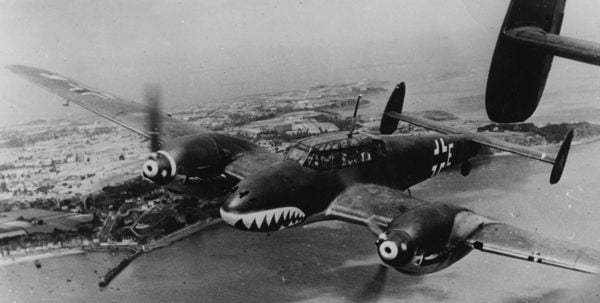
Frontline Report: Erprobungsgruppe 210
The Bf110 is now available to pre-order for Blood Red Skies. This week, we’re looking at one of the first squadrons to test them in their ground-attack role – Erprobungsgruppe 210!
The Erprobungsgruppe (Literally translated as Test Wing) was a small administrative unit created to test experimental aircraft or tactics.
Erprobungsgruppe 210 (Erpro 210) was created in the summer of 1940, with recruits drawn from two existing heavy fighter formations. This small unit of 39 aircraft was originally formed to test the Me210 heavy fighter, but technical problems meant that the unit was re-equipped with the Bf110 and thrown straight into the Battle of Britain.
At the time of its formation, Erpro 210 consisted of 3 12-aircraft staffeln and a 3-aircraft stabschwarm. 2 Staffeln were equipped with Bf 110s (both the C and D model), while the third staffeln was equipped with Bf 109Es.
The Bf 110 was wholly unsuited in its role as a bomber escort, day fighter or ground attack aircraft. The squadrons equipped with them suffered heavy casualties as a result
Destroyers!
Gentlemen, be very careful if you should ever come up against the English. Their fighters are all single-engined. And once they get to know the Bf 110s weaknesses, you could be in for a very nasty surprise.
Walter Horten, JG26 Technical Officer
The principal advantage of the Bf 110 was its unusually heavy armament for the time. Packing four 7.92mm machine guns and two 20mm cannons in its nose, alongside another rear-mounted machine gun, it completely outclassed any of the fighters ranged against it in firepower.
Unfortunately, the design was compromised by poor speed and manoeuvrability, and insufficient defensive armament. At low speeds, it proved to be sluggish and unresponsive, simply unable to keep up with the much faster monoplane fighters used by the RAF.
It was marginally better as a ground attack aircraft than a heavy fighter or bomber escort. Able to carry 500kg and 1000kg bombs, along with its considerable arsenal of guns and cannons, it was considered perfect for the precision bombing of point targets and strafing airfields.
Erpro 210 gained a reputation for being crack precision bombers, screaming in at low altitude over radar stations and airfields, releasing their deadly cargo then vanishing into the blue. When opposed by anti-aircraft guns, with the air cover still struggling to get off the ground, the Bf 110 was a real menace.
When caught at high altitude, or forced to escort bombers, the Bf 110 was a poor match for a Hurricane or Spitfire needing escorts of its own. Attacking from the plane’s rear quarter, an enemy aircraft could dive on their much slower opponent, lacerating them with machine gun fire and zooming off at even higher speed.
Reassigned Eastward
In the spring of April 1941, the unit was re-designated as Schnellkampfgeschwader 210 (SG210) and sent eastward for the commencement of Operation Barbarossa. Between 22 June 1941 and 26 July 1941 the unit claimed to have destroyed 823 Soviet aircraft on the ground and 92 in the air, 2,136 vehicles and 165 tanks destroyed for 57 Bf 110s lost to enemy action.
In early 1942, the formation was absorbed back into Zerstorergeschwader 76, but these crack pilots would continue flying ground-attack missions until the very end of the war.
Erpro 210 in Blood Red Skies
Make sure you pick up some of our fantastic new Bf 110s, available for pre-order today and in stores early 2019!
Keep your eyes peeled over the next few weeks for an article on Erpro 210’s camouflage schemes and aircraft markings!
The post Frontline Report: Erprobungsgruppe 210 appeared first on Warlord Games.





